Introduction
You need two things on the road: protection and awareness. Block too much sound and you numb your response to horns, sirens, and other riders. Block too little and your ears pay the price. The trick is to reduce harmful energy without cutting the cues that keep you safe. This article explains how to strike that balance using gear and common-sense habits.
Know what you’re trying to preserve
Wind noise is broad and relentless. It’s the background roar that wears you out and pushes you to crank music. At the same time, you need to hear higher-priority sounds. Filtered protection aims to drop harmful decibel levels while maintaining the clarity of speech and alarms.
When you compare products, seek those with rider feedback. Riders often point to models that feel quiet but still let them recognize a horn or a shout. Those are the best motorcycle earplugs for practical use on the road.
Start with helmet and aerodynamics
A well-fitting helmet and a clean shield reduce turbulence and lower the baseline noise before plugs come into play. Small changes in helmet fit or visor position can reduce the level of wind energy that reaches your ears, and that makes any plug more effective.
If your helmet leaks or vibrates at speed, no earplug will make much difference. Solve the helmet first, then add protection.
Filtered plugs are your ally
Filtered plugs are designed to reduce sound evenly so the character of noise is preserved. That means speech remains intelligible and warning sounds still cut through. For everyday riding, filtered plugs often provide the best balance between safety and protection.
The best earplugs for motorcycle wind noise will cut fatigue without shattering situational awareness. Try a few models and pick one that preserves clarity at highway speeds.
Learn to insert and confirm the seal
Improper insertion ruins performance. Take the time to master the insertion method for your chosen tips. Foam must expand fully; silicone needs a firm seat. Check the seal with a quick test: a normal conversation should sound lower but not muffled.
If you find yourself constantly adjusting, the fit is wrong and your awareness could suffer. Keep practicing until the plugs feel natural in the helmet.
Use layered strategies
A combination approach, helmet tuning, shield adjustments, and the right plugs, yields the best results. Each element chips away at noise so you never have to rely on one fix alone. For example, a snug helmet plus filtered plugs can reduce wind roar enough that you don’t need loud music to mask it.
Layered measures also mean you can adjust for conditions. On quiet country roads you might use lighter filters. In heavy crosswinds you can switch to a slightly higher attenuation.
Test in real conditions, not in a store
The laboratory isn’t the whole story. Do test rides on familiar roads to see how a product behaves at 55 mph and above. Note whether horns and navigation prompts remain audible and whether mental fatigue decreases over a long stretch.
Rider reviews and real-world testing often reveal how products handle turbulence and crosswinds. Those are the contexts where the best motorcycle earplugs for practical riding prove themselves.
Keep communication in mind
If you ride in a group, consider systems that allow clear radio traffic or intercom use without removing protection. Some filters and audio systems pair well; others don’t. Choose combinations that let you communicate at stops and on the move without compromising safety.
Conclusion
You don’t have to choose between hearing protection and situational awareness. Filtered plugs combined with a well-fitted helmet and common-sense habits give you both. Pick the best motorcycle earplugs for conditions you ride in, learn to insert them correctly, and layer solutions so you’re never relying on a single fix. Do that and you’ll cut fatigue, stay alert, and keep the sounds that matter intact.

















Add comment